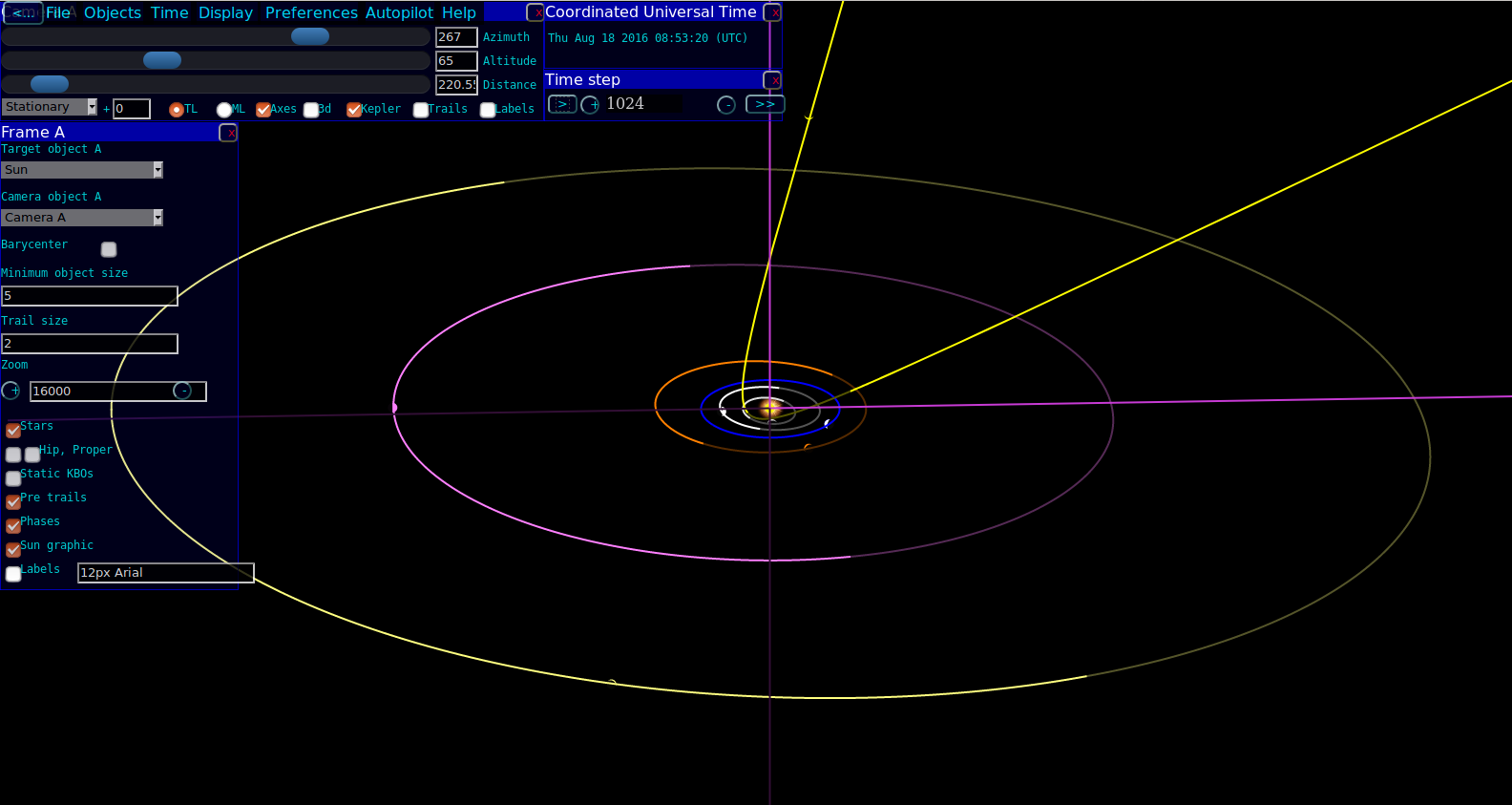
Contents
In late October, 2017, I saw this message on the Minor Planet Mailing List :
Hello all, This object is currently on the MPC's comet confirmation page, with a six-day arc. And as the subject says, it is _very_ weird. It came to my attention because it "broke" the on-line Find_Orb. If you try copying the observations to it, you'll see that it can only fit a short arc. The reason is that the observations actually correspond to the following quite exotic orbit : Orbital elements: P10Ee5V Perihelion 2017 Sep 9.391124 +/- 0.0706 TT = 9:23:13 (JD 2458005.891124) Epoch 2017 Oct 20.0 TT = JDT 2458046.5 Earth MOID: 0.1000 Me: 0.0551 q 0.25022063 +/- 0.00378 Ma: 0.0616 Gray H 22.3 G 0.15 Peri. 240.77610 +/- 0.6 Node 24.62085 +/- 0.016 e 1.1863100 +/- 0.00941 Incl. 122.20101 +/- 0.36 31 of 34 observations 2017 Oct. 18-24; mean residual 0".332 Which corresponds to something barrelling in toward the sun with an incoming speed, from infinity, of about 26.0 +/- 0.5 km/s.
Now, the paragraph describing the orbital elements contains the vital piece of information that made this object seem so exotic. Can you find it?
Q: Which of the numbers in the "orbital elements"
section of the message is the really important one?
Q: And what's so special about it?
Yes, that's right: the important number is the one labelled e.
e 1.1863100 +/- 0.00941
Within 24 hours, the Minor Planet Center issued a Minor Planet Electronic Circular, MPEC 2017-U181 , which listed all the measurements of this object and noted its unusual nature. Let's take a detailed look at this message ...
M.P.E.C. 2017-U181 Issued 2017 Oct. 25, 03:53 UT
The Minor Planet Electronic Circulars contain information on unusual
minor planets and routine data on comets. They are published
on behalf of Division F of the International Astronomical Union by the
Minor Planet Center, Smithsonian Astrophysical Observatory,
Cambridge, MA 02138, U.S.A.
Prepared using the Tamkin Foundation Computer Network
MPC@CFA.HARVARD.EDU
URL http://www.minorplanetcenter.net/ ISSN 1523-6714
COMET C/2017 U1 (PANSTARRS)
Further observations of this object are very much desired. Unless there
are serious problems with much of the astrometry listed below, strongly
hyperbolic orbits are the only viable solutions. Although it is probably
not too sensible to compute meaningful original and future barycentric orbits,
given the very short arc of observations, the orbit below has e ~ 1.2 for
both values. If further observations confirm the unusual nature of this
orbit, this object may be the first clear case of an interstellar comet.
First, the object is given a new designation: COMET C/2017 U1 (PANSTARRS). The name means that it is the first comet discovered in 'U' portion the year 2017. What does 'U' stand for? It means the second half of the month of October. ('A' = first half of January, 'B' = second half of January, 'C' = first half of February, and so on). The (PANSTARRS) indicates that the first person or team to report the object was the Panoramic Survey Telescope and Rapid Response System which operates a 1.8-meter telescope on Haleakela in Hawaii.
Next come the measurements:
Observations:
CK17U010 C2017 10 18.47298 01 59 57.442+02 06 04.30 19.8 TLEU181F51
CK17U010 C2017 10 18.49990 01 59 08.910+02 07 20.19 LEU181F51
CK17U010 C2017 10 19.39715 01 34 55.362+02 45 03.20 19.9 TLEU181F51
CK17U010 C2017 10 19.40837 01 34 38.745+02 45 28.24 19.9 TLEU181F51
CK17U010 C2017 10 19.41968 01 34 21.948+02 45 53.55 20.1 TLEU181F51
CK17U010 C2017 10 19.43106 01 34 05.174+02 46 18.89 20.1 TLEU181F51
CK17U010 KC2017 10 19.86072 01 24 07.89 +03 01 07.5 19.6 TUEU181104
CK17U010 KC2017 10 19.86492 01 24 02.21 +03 01 16.3 19.8 TUEU181104
CK17U010 KC2017 10 19.86905 01 23 56.69 +03 01 24.7 20.3 TUEU181104
CK17U010 KC2017 10 19.94093401 22 22.288+03 03 53.76 20.3 TUEU181J04
CK17U010 KC2017 10 19.94390101 22 18.372+03 03 59.57 20.1 TUEU181J04
CK17U010 C2017 10 20.17250 01 17 27.47 +03 11 07.8 19.9 TUEU181I52
CK17U010 C2017 10 20.17348 01 17 26.22 +03 11 09.6 20.2 TUEU181I52
CK17U010 C2017 10 20.17448 01 17 24.96 +03 11 11.3 20.2 TUEU181I52
CK17U010 C2017 10 20.17546 01 17 23.73 +03 11 13.0 20.6 TUEU181I52
CK17U010 KC2017 10 21.22371 00 57 56.30 +03 39 16.9 20.2 ToEU181291
CK17U010 KC2017 10 21.22623 00 57 53.76 +03 39 20.5 19.5 ToEU181291
CK17U010 KC2017 10 21.22877 00 57 51.19 +03 39 24.2 19.6 ToEU181291
CK17U010 C2017 10 21.37476 00 55 26.71 +03 42 45.0 20.4 ToEU181926
CK17U010 C2017 10 21.37804 00 55 23.53 +03 42 49.8 20.1 ToEU181926
CK17U010 C2017 10 21.38132 00 55 20.35 +03 42 53.7 20.4 ToEU181926
CK17U010 |C2017 10 22.29708 00 41 56.27 +04 01 25.0 vEU181H06
CK17U010 |C2017 10 22.30118 00 41 52.93 +04 01 29.3 vEU181H06
CK17U010 |C2017 10 22.30512 00 41 49.76 +04 01 33.5 20.7 TvEU181H06
CK17U010 1C2017 10 22.46548 00 39 44.84 +04 04 55.4 EU181Q62
CK17U010 1C2017 10 22.47027 00 39 41.16 +04 04 59.9 EU181Q62
CK17U010 1C2017 10 22.47506 00 39 37.39 +04 05 04.8 19.9 T EU181Q62
CK17U010 KC2017 10 23.18830 00 31 01.55 +04 16 02.6 20.4 TqEU181734
CK17U010 KC2017 10 23.19547 00 30 56.65 +04 16 08.7 20.1 TqEU181734
CK17U010 KC2017 10 23.20264 00 30 51.76 +04 16 14.6 20.4 TqEU181734
CK17U010 C2017 10 24.23395 00 20 19.64 +04 30 08.4 20.9 TUEU181G96
CK17U010 C2017 10 24.23917 00 20 16.75 +04 30 12.3 UEU181G96
CK17U010 C2017 10 24.24438 00 20 13.82 +04 30 15.6 21.0 TUEU181G96
CK17U010 C2017 10 24.24957 00 20 10.85 +04 30 19.7 20.7 TUEU181G96
Q: How bright was the object? Q: What span of time is covered by these measurements?
That's right -- only six days. With such a short "arc" of its trajectory, astronomers were only able to compute a very rough orbit. But even the rough orbit revealed this object's peculiar nature.
The next portion of the MPEC shows the list of astronomers whose measurements were used for the orbit calculations:
Observer details:
104 San Marcello Pistoiese. Observers P. Bacci, M. Maestripieri. Measurers
P. Bacci, L. Tesi, G. Fagioli. 0.60-m f/4 reflector + CCD.
291 LPL/Spacewatch II. Observer R. A. Mastaler. 1.8-m f/2.7 reflector + CCD.
734 Farpoint Observatory. Observer G. Hug. 0.69-m reflector + CCD.
926 Tenagra II Observatory. Observers M. Schwartz, P. R. Holvorcem. Measurer
M. Schwartz. 0.81-m f/7 Ritchey-Chretien + CCD.
F51 Pan-STARRS 1, Haleakala. Observers J. Bulger, T. Lowe, A. Schultz,
M. Willman. Measurers K. Chambers, S. Chastel, L. Denneau, H. Flewelling,
M. Huber, E. Lilly, E. Magnier, R. Wainscoat, C. Waters, R. Weryk. 1.8-m
Ritchey-Chretien + CCD.
G96 Mt. Lemmon Survey. Observer G. J. Leonard. Measurers E. J. Christensen,
D. C. Fuls, A. R. Gibbs, A. D. Grauer, J. A. Johnson, R. A. Kowalski,
S. M. Larson, G. J. Leonard, R. G. Matheny, R. L. Seaman, F. C. Shelly.
1.5-m reflector + 10K CCD.
H06 iTelescope Observatory, Mayhill. Observer H. Sato. 0.43-m f/6.8
astrograph + CCD + f/4.5 focal reducer.
I52 Steward Observatory, Mt. Lemmon Station. Observer R. A. Kowalski.
Measurers E. J. Christensen, D. C. Fuls, A. R. Gibbs, A. D. Grauer,
J. A. Johnson, R. A. Kowalski, S. M. Larson, G. J. Leonard, R. G. Matheny,
R. L. Seaman, F. C. Shelly. 1.0-m reflector + CCD.
J04 ESA Optical Ground Station, Tenerife. Observer D. Abreu. Measurers
M. Micheli, D. Koschny, M. Busch, A. Knoefel, E. Schwab. 1.0-m f/4.4
reflector + CCD.
Q62 iTelescope Observatory, Siding Spring. Observer H. Sato. 0.51-m f/6.8
astrograph + CCD + f/4.5 focal reducer.
Ten different sites contributed to this very early orbit! That's a good sign that plenty of astronomers are scanning the heavens (and reporting their observations) on a regular basis. Phew!
The trouble was, the object was discovered on its way OUT of the Solar System. It was moving away from the Sun, and away from the Earth, and doing so rapidly.
Let me illustrate by using Tony Dunn's Orbit Simulator, an excellent piece of free software that can run in your browser or as a standalone program.
When the MPEC was issued, on Oct 24, 2017, the object was already closer to the orbit of Mars than to that of the Earth. Its distance from the Sun was 1.34 AU, and its distance from the Earth was 0.36 AU.
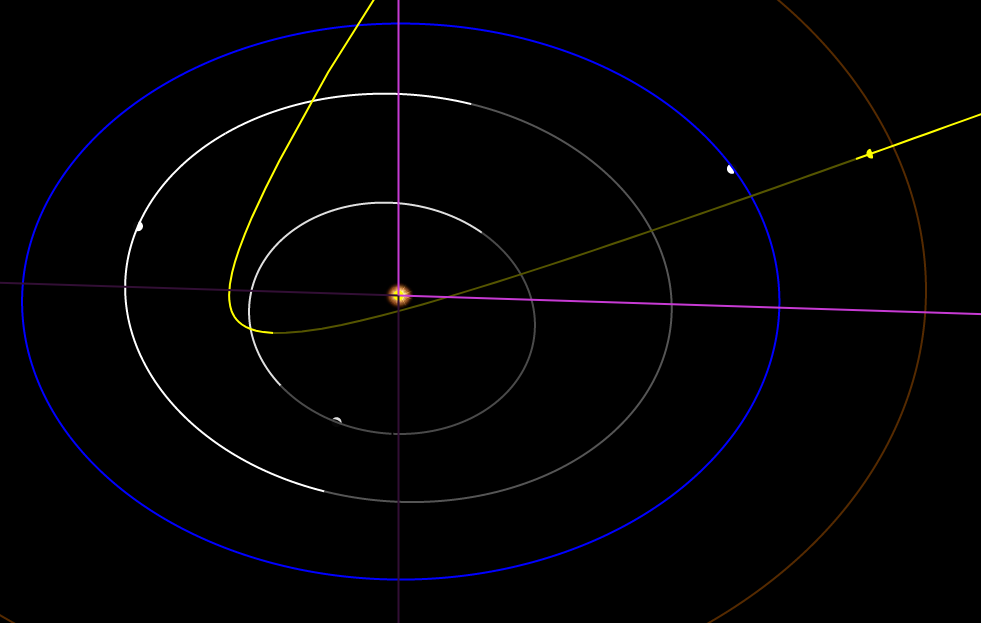
Within one week, on Nov 1, 2017, the object would zoom past the orbit of Mars (out to 1.52 AU from the Sun), and almost DOUBLE its distance from the Earth, to 0.63 AU.
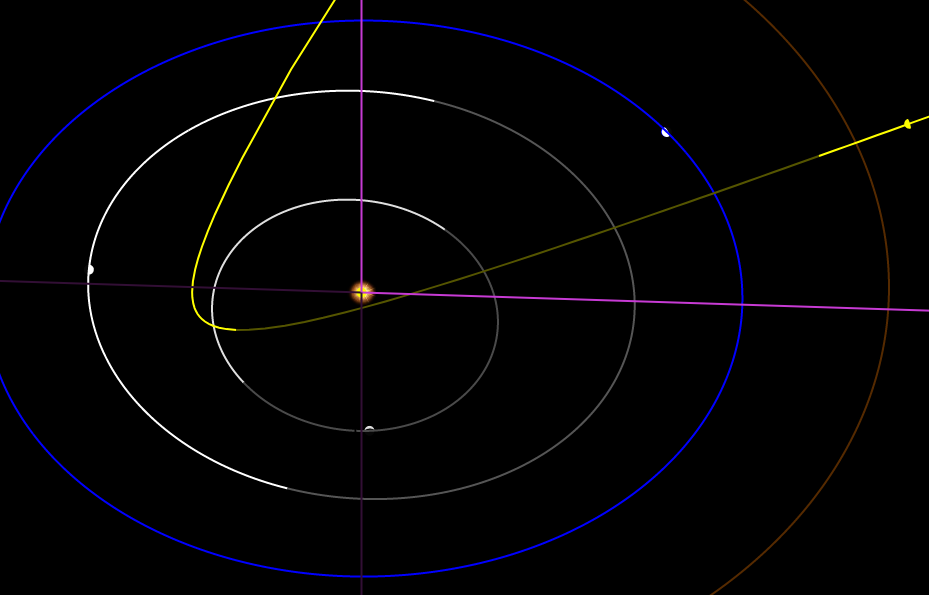
Over this period of just seven days, the apparent magnitude of the object increased from about 21.4 to about 23.2; in other words, the flux from the object on Nov 1 was just about 20% of its value at discovery.
If humans were going to learn anything about the mysterious, fast-moving object, they would have to get cracking!
And get cracking they did!
The first order of business was to take pictures of the object. Let's take a look at a few. First, note that "ordinary" astronomical pictures just wouldn't do the trick. The object was moving so fast that it would leave trails on the multi-minute exposures required to detect it. Therefore, astronomers employed non-sidereal tracking rates, placing all the photons from the object in a sharp little spot, while smearing out the light from ordinary stars. The upper panel below (from Jewitt et al. 2017 ) is the sum of 12 x 120-seconds on the 2.5 Nordic Optical Telescope; the lower panel is the median of those same images, showing only the light from the object.
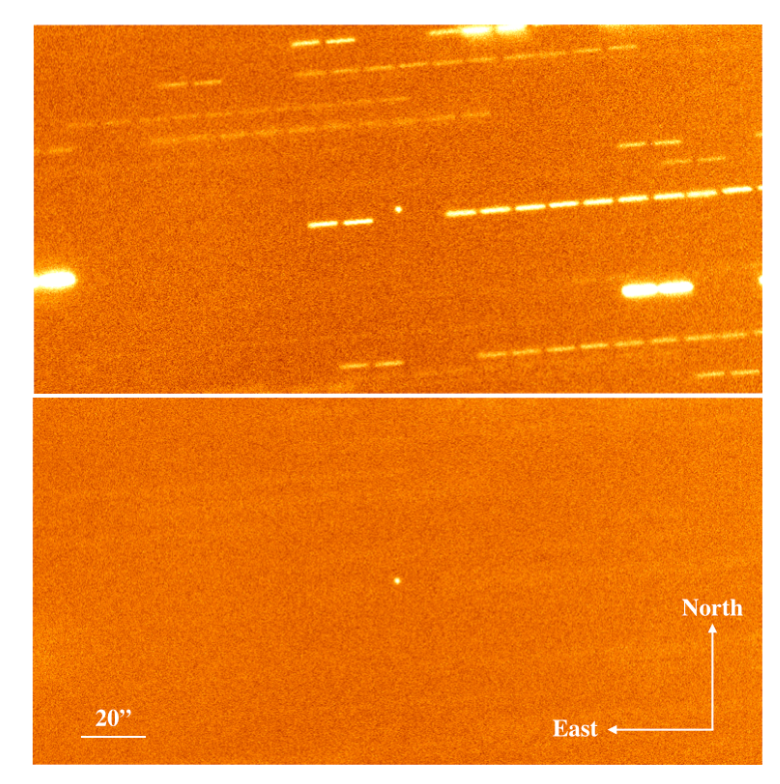
Figure 1 taken from
Jewitt et al., arXiv 1711.05687 (2017)
Q: Does it look like a comet? Like a spaceship?
Explain.
Hmmm. Comets usually have big clouds of glowing gas and dust surrounding them when they fly through the inner Solar System. You know, like this:
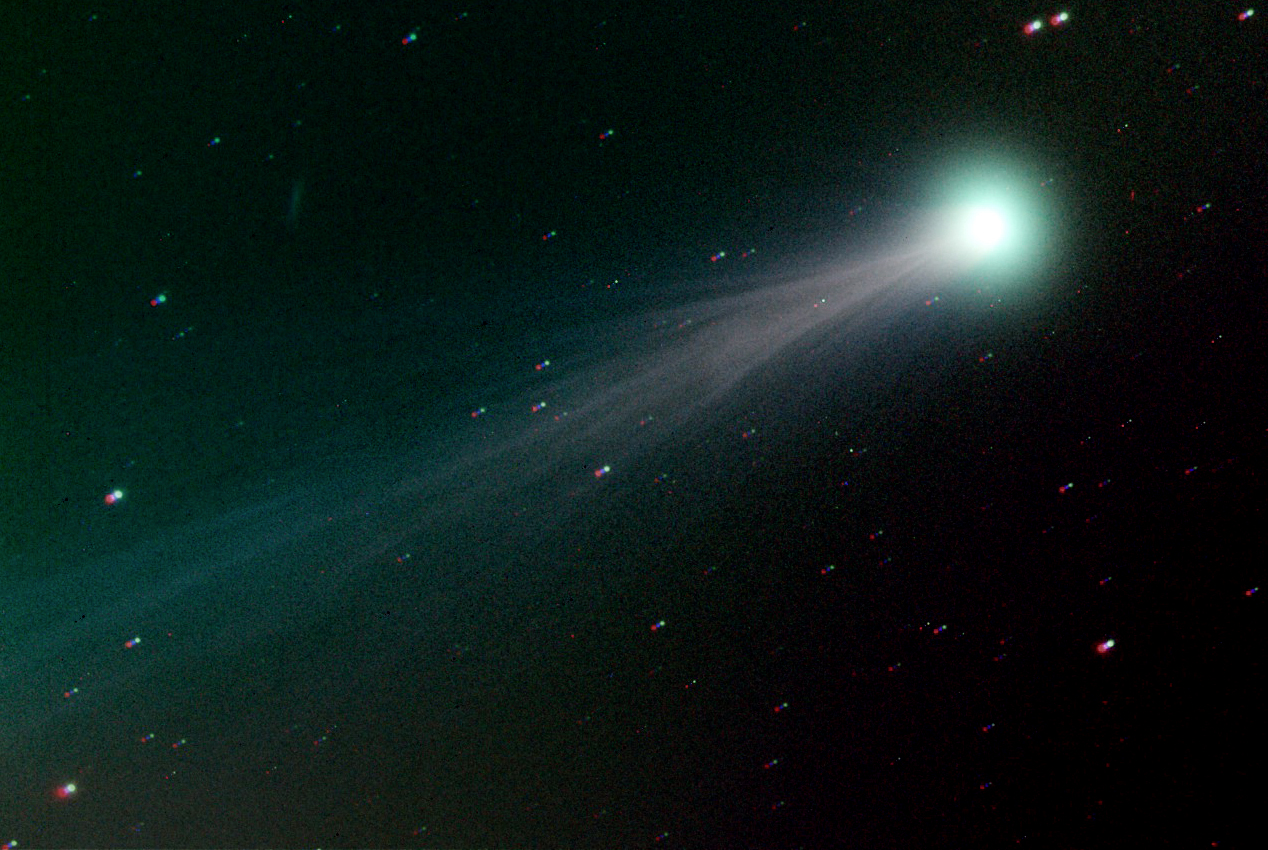
Image of Comet ISON courtesy of
Mike Hankey
But the mystery object didn't have any coma, nor any tail. It looked pretty much like a dot. In fact, VERY much like a dot. An unresolved point source, in other words.
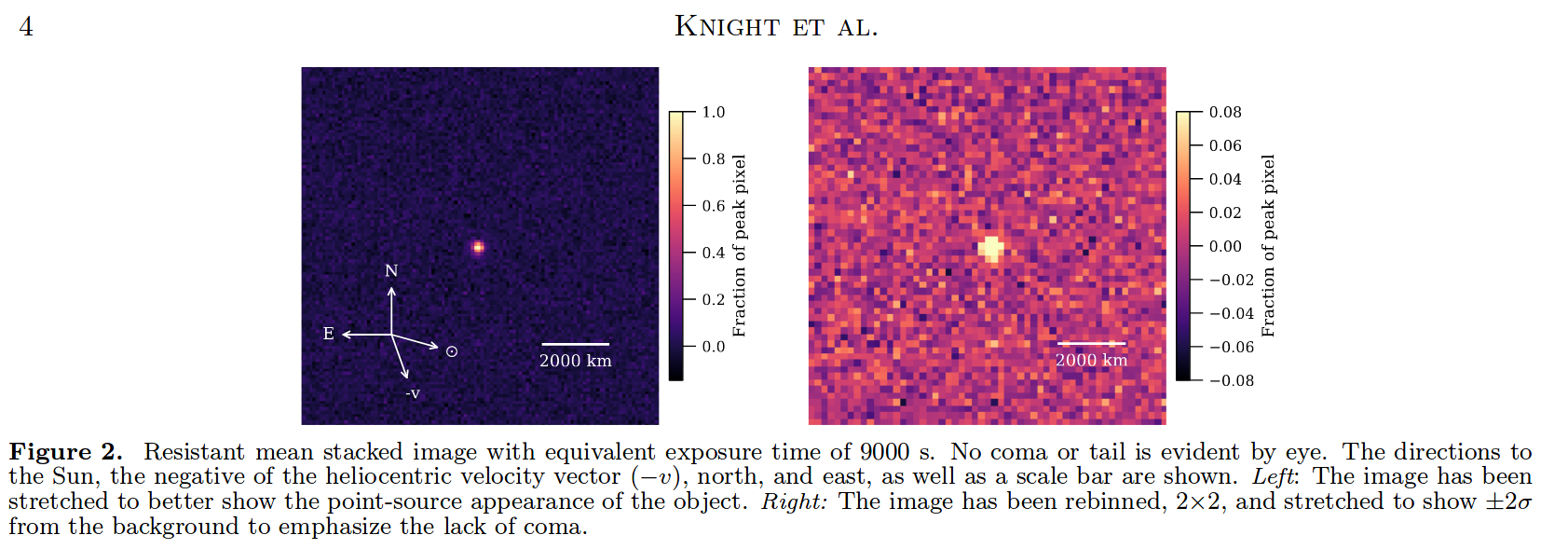
Figure 2 taken from
Knight et al., arXiv 1711.01402 (2017)
In the figure below, Knight et al., arXiv 1711.01402 (2017) compare the shape of the object in a single 300-second image (blue dots), and in a stack of many frames (black circles), to the shape of an ordinary star (red line).
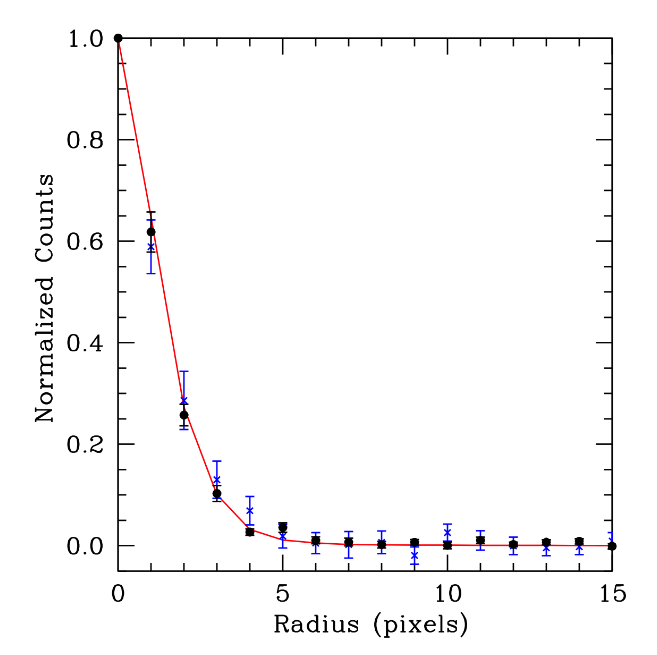
One panel from Figure 3 taken from
Knight et al., arXiv 1711.01402 (2017)
Nope. No extended emission. And that means that maybe "comet" isn't the best word to describe the object. Maybe something like "asteroid" or "rock" might be better.
And so, in MPEC 2017-U183 , issued on 2017 Oct 25, the Minor Planet Center modified its designation for the object. No longer would it be "C/2017 U1", where the "C" stands for "Comet." It would now be named "A/2017 U1", in which "A" stands for "Asteroid."
M.P.E.C. 2017-U183 Issued 2017 Oct. 25, 22:22 UT
The Minor Planet Electronic Circulars contain information on unusual
minor planets and routine data on comets. They are published
on behalf of Division F of the International Astronomical Union by the
Minor Planet Center, Smithsonian Astrophysical Observatory,
Cambridge, MA 02138, U.S.A.
Prepared using the Tamkin Foundation Computer Network
MPC@CFA.HARVARD.EDU
URL http://www.minorplanetcenter.net/ ISSN 1523-6714
A/2017 U1
K. Meech (Institute of Astronomy, University of Hawaii) reports that in a
very deep stacked image, obtained with the VLT, this object appears completely
stellar. The prefix for the designation 2017 U1 is therefore being changed to
A/, in line with the 1995 IAU Resolution on the system of comet designations.
Okay, fine. It's not a comet. But ... what is it? One way astronomers can determine the physical nature of an object is to break its light into a spectrum and look for absorption or emission lines due to particular elements or molecules. Joseph Maserio used the 200-inch telescope at Mount Palomar to take a spectrum of the object on 2017 Oct 25, just one day after the discovery announcements. Let's look at his result:
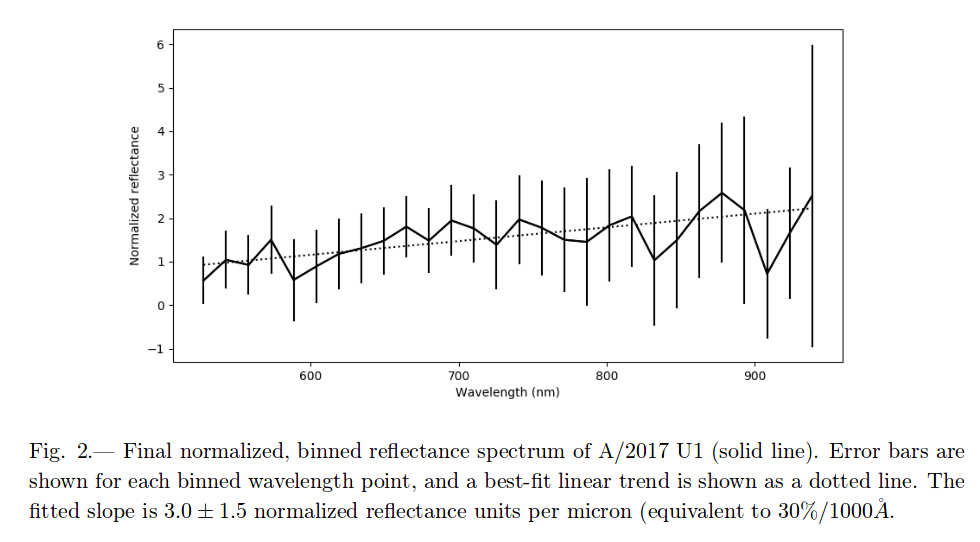
Figure 2 taken from
Masiero, arXiv 1710.09977 (2017)
Q: What does this spectrum tell us about the object?
Well, it tells me that the object is ... sort of reddish. Sigh.
But wait! Maybe even a simple color can give us clues about the body's composition. To be more precise, perhaps TWO colors can do the trick. Astronomers measured the magnitude of the comet through three different filters, B, V, and R, then calculated two "colors" via subtraction: (B-V) and (V-R). If one places the colors of different types of objects into a "color-color" diagram, one can see some patterns. The red symbols denote objects which lie in the Kuiper Belt -- in the outer regions of the Solar System -- while the blue symbols belong to bodies closer to the inner region. Black letters in circles show the average values of various asteroid groups.
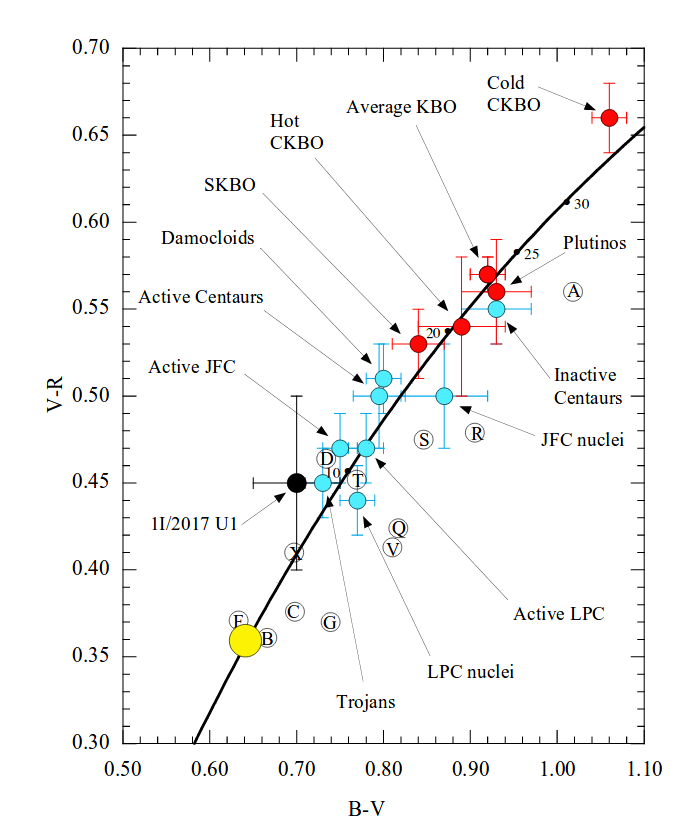
Figure 5 taken from
Jewitt et al., arXiv 1711.05687 (2017)
Q: What do the colors of 2017 U1 say about its origin?
Hmmmm.
One final conclusion that astronomers could draw from their frantic few nights of measurements was that this object was rotating, as its brightness varied over the course of 8 hours or so.
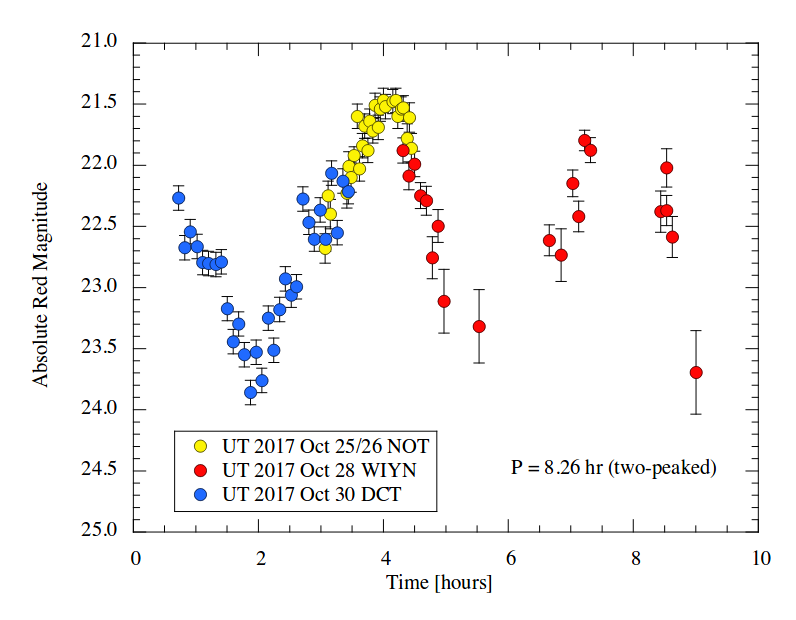
Figure 3 taken from
Jewitt et al., arXiv 1711.05687 (2017)
The SIZE of the variations in brightness suggest that either the body has large regions of very different color and reflectivity, or that its shape is long and thin (when we see the long dimension from the side, it shows a large area, and so is bright; when we see the narrow end pointing at us, it shows a small area, and so is faint). If the shape is responsible for the light curve, then the ratio of long to short axes must be at least 6 to 1.
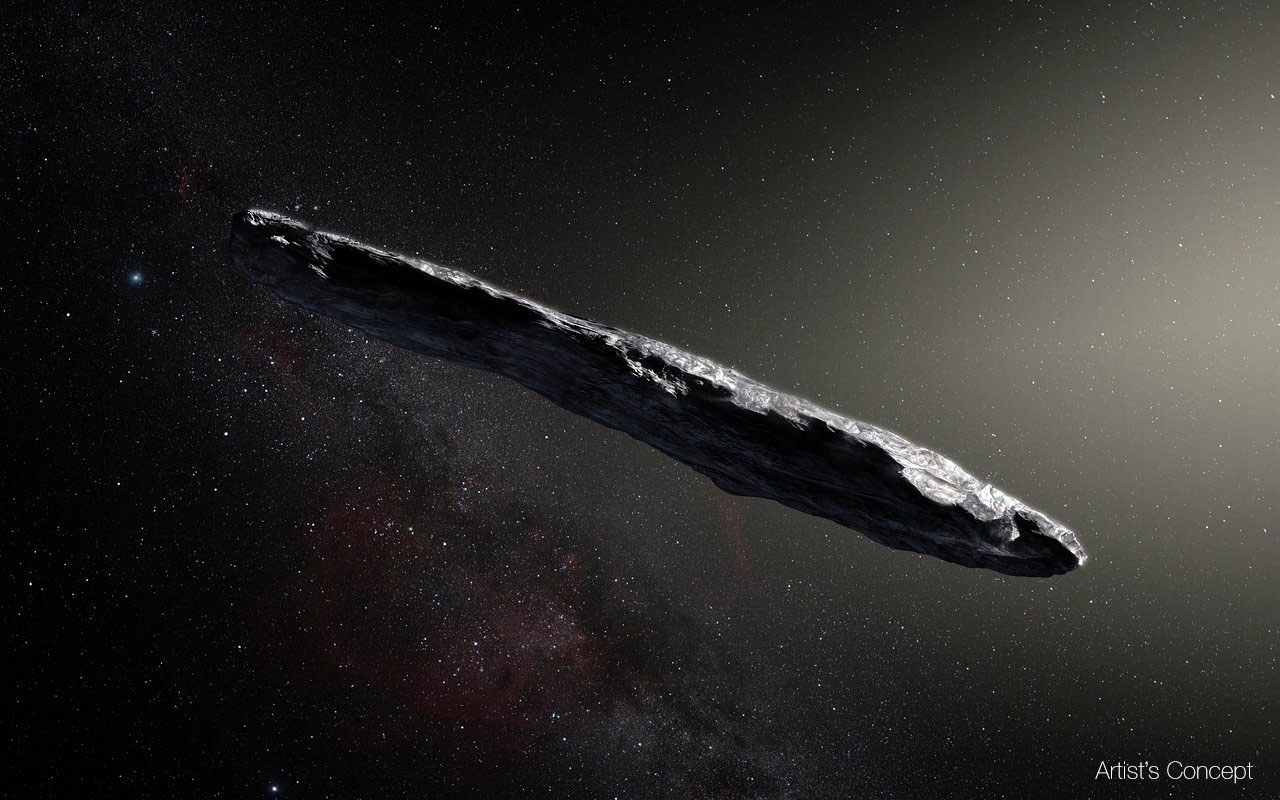
Artist's rendition of the object
courtesy of
European Southern Observatory/M. Kornmesser
But, if one puts together all the measurements by different observers, one can see that the variations in brightness do not repeat in a simple periodic manner:
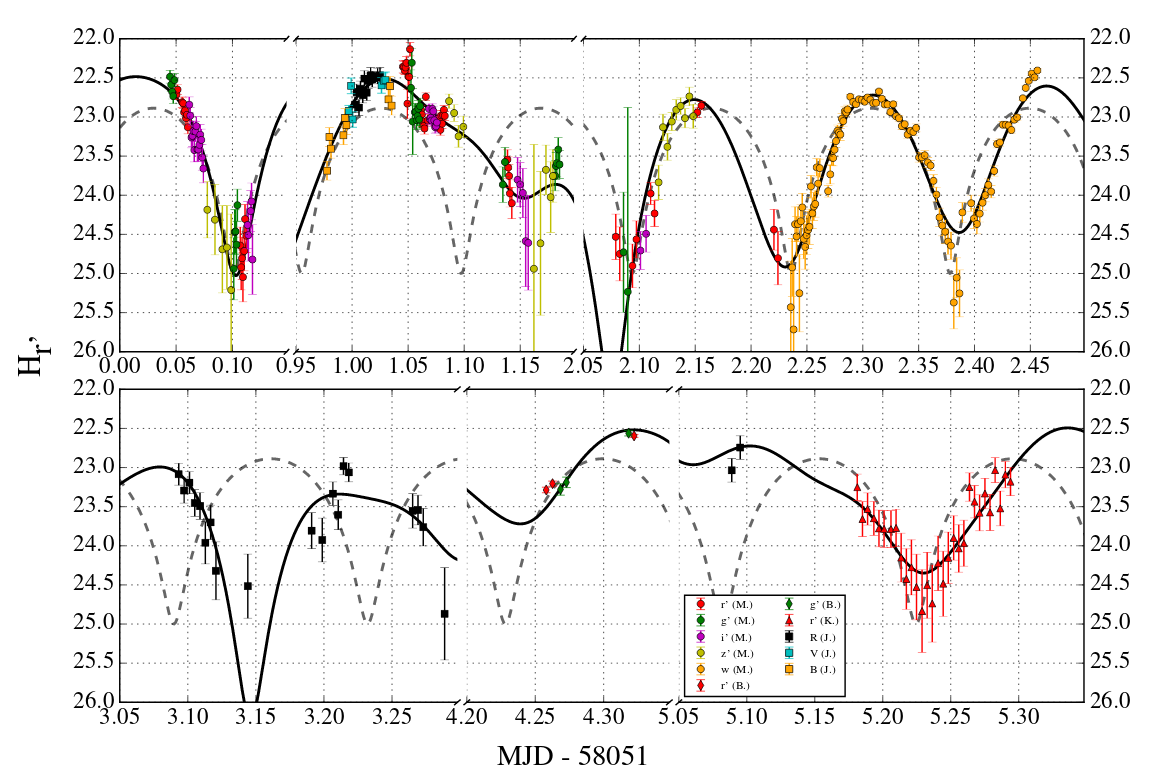
Figure 1 taken from
Fraser et al., arXiv 1711.11530 (2017)
One way to explain this wierd light curve is to postulate that the asteroid is not rotating, but TUMBLING in a chaotic manner. Perhaps this is a clue to the body's origin ...

Title of
a paper by Drahus et al., arXiv1712.00437 (2017)
As information about the shape and trajectory of `Oumumua spread, some people began to speculate about its nature. Some of the usual suspects in the media trumpeted the possibility that the object was an alien spaceship. After all, it was long and thin, and moving very quickly through our solar system; and decades of books and movies and TV shows have taught us that this is EXACTLY what spaceships do.

Image courtesy of
In the Mouth of Dorkness
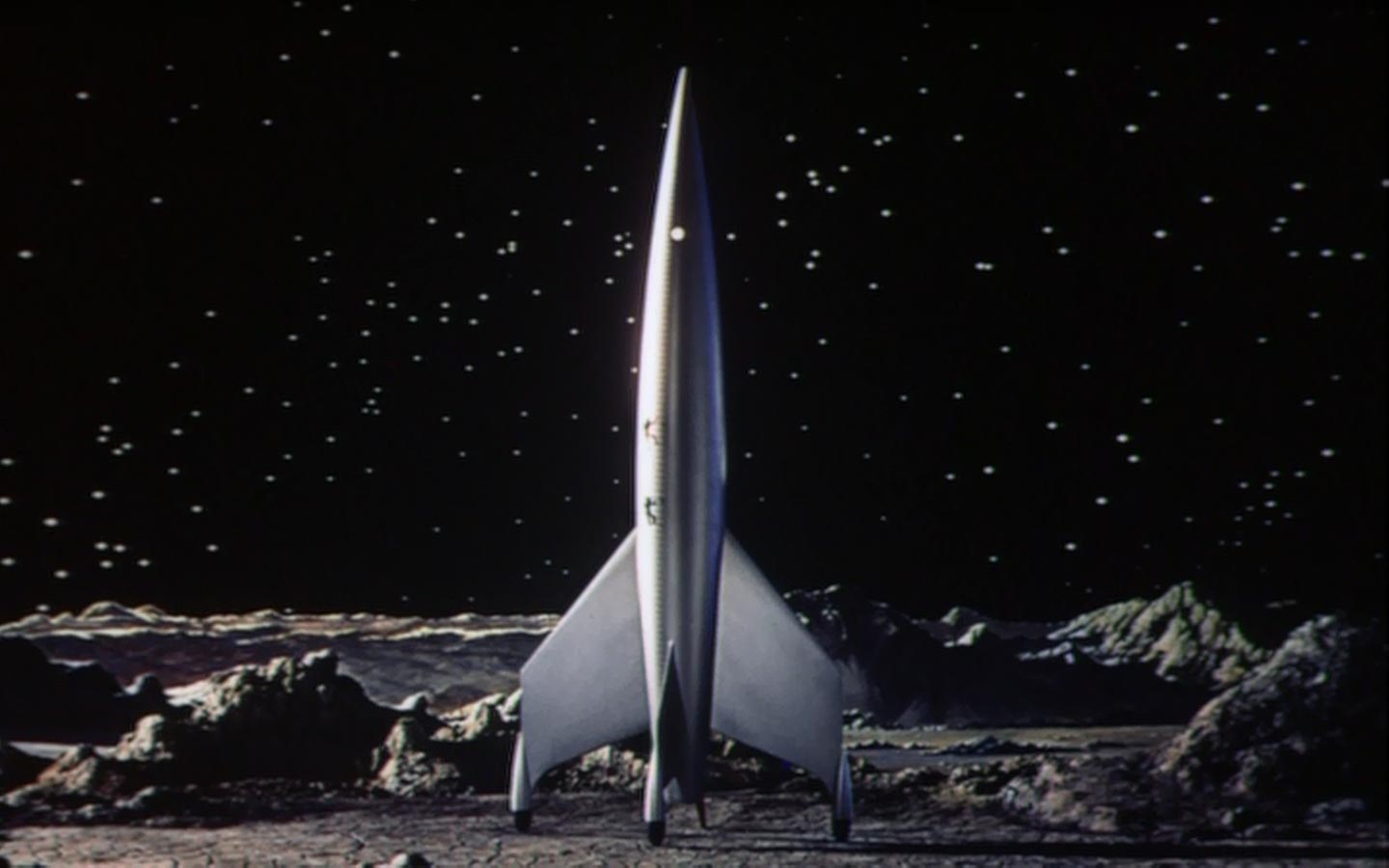
Image courtesy of
Retro Rockets
If it were a spaceship, then perhaps it would be broadcasting messages. Astronomers checked to see if the object was emitting radio waves ...
In neither case were any interesting signals detected. The upper limits on the transmitting power vary, depending on the instrument used and the nature of the assumed signal (narrowband? continuous? pulsed?), but range from less than 1 Watt to several hundred kWatts. In every case, however, it seems clear that the required radio power would be well within the capabilities of an interstellar spacecraft.
So, this object was moving way too fast to be a member of our own Solar System. Even if a comet in the farthest reaches of our Oort Cloud were to slip inward and fall billions of kilometers toward the Sun, picking up speed as it went, it would move past the Earth at no more than 42 km/sec. But this object was zooming at about 49 km/sec as it passed the Earth's orbit.
There was no doubt about it: this was a VISITOR FROM ANOTHER STAR!
And so, its name changed again. No longer would it be A/2017 U1, for "asteroidal body", but 1I/'Oumuamua, where the new and never-before-granted designation of I stands for Interstellar.
M.P.E.C. 2017-V17 Issued 2017 Nov. 6, 21:00 UT
The Minor Planet Electronic Circulars contain information on unusual
minor planets and routine data on comets. They are published
on behalf of Division F of the International Astronomical Union by the
Minor Planet Center, Smithsonian Astrophysical Observatory,
Cambridge, MA 02138, U.S.A.
Prepared using the Tamkin Foundation Computer Network
MPC@CFA.HARVARD.EDU
URL http://www.minorplanetcenter.net/ ISSN 1523-6714
NEW DESIGNATION SCHEME FOR INTERSTELLAR OBJECTS
The discovery of A/2017 U1 has presented a slight nomenclature problem.
Since both the original and future barycentric orbits for this object are
significantly hyperbolic, this object is not bound to our solar system and the
current apparition is likely to be the only time that the object is observable.
Due to the unique nature of this object, there is pressure to assign a
name. The minor-planet designation scheme does not allow a name to be assigned
to this object based on the brief arc of observation.
Recent e-mail exchanges between the IAU General Secretary, the IAU
Division F President, the co-chairs of the IAU Working Group on Small Body
Nomenclature and the Minor Planet Center have discussed this nomenclature
issue. A solution has been proposed that solves the problem. A new series of
small-body designations for interstellar objects will be introduced: the I
numbers. This new sequence will be similar in form to the comet numbering
system and assignment of the numbers will be handled by the Minor Planet
Center.
Moreover, it was given the name Oumuamua, Hawaiian for "scout" or "first messenger." Very appropriate, don't you think?
But if it came from some other star system, WHICH ONE was it? That's the $64,000 Question. Astronomer Eric Mamajek (who has left the snowy fields of Rochester for a new home at JPL) computed the velocity which Oumuamua must have had before it fell into the gravitational well of our Sun. He broke that velocity down into three components:
Stars like the Sun and its ordinary neighbors should have values which are not too far from (0, 0, 0). Let's see if Oumuamua has a velocity similar to that of any nearby stars ...
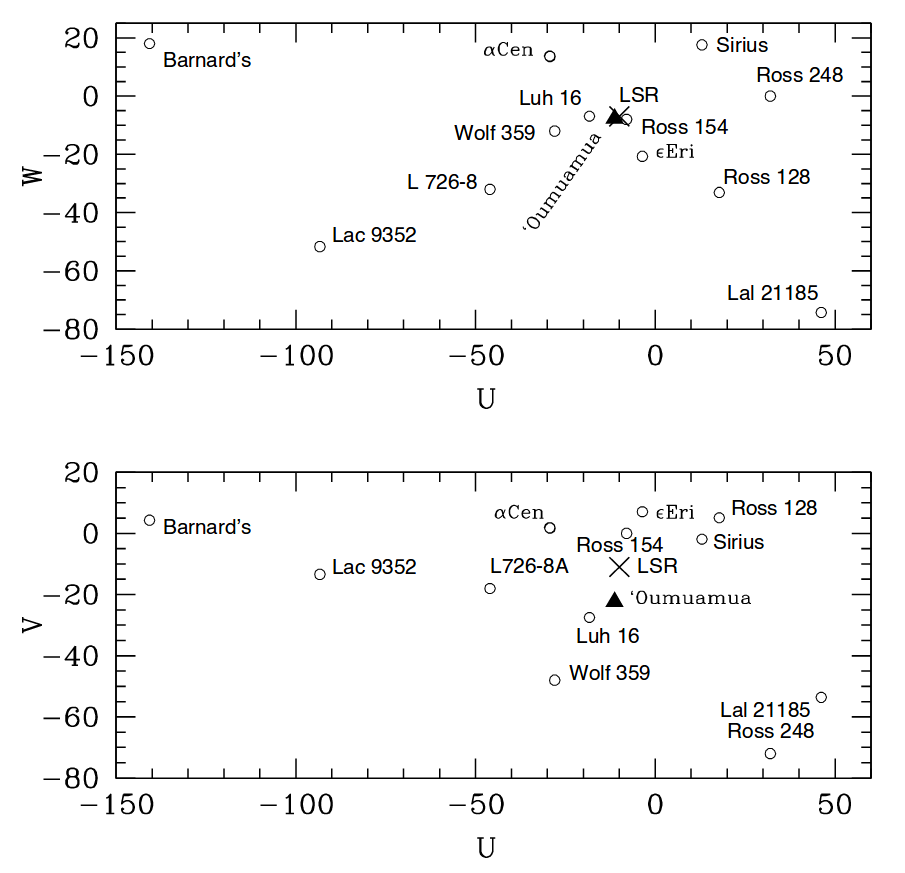
Figure 1 taken from
Mamajek, arXiv 1710.11364 (2017)
Eric concludes:

And that ... is where we stand today.